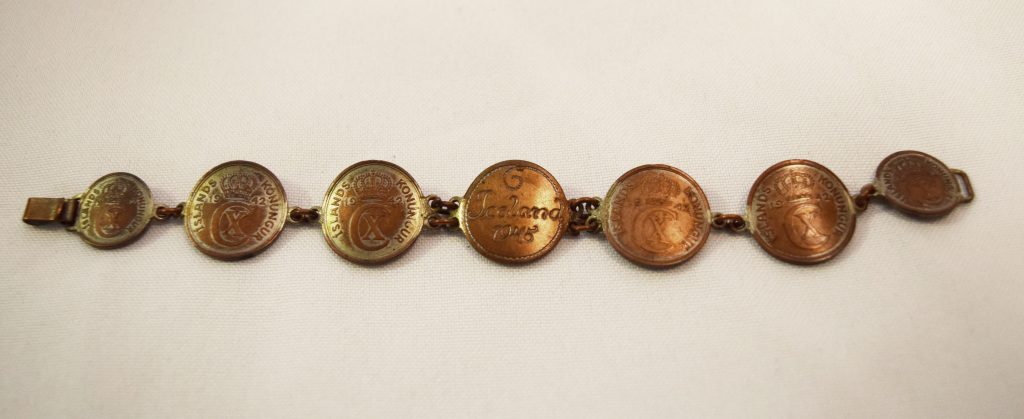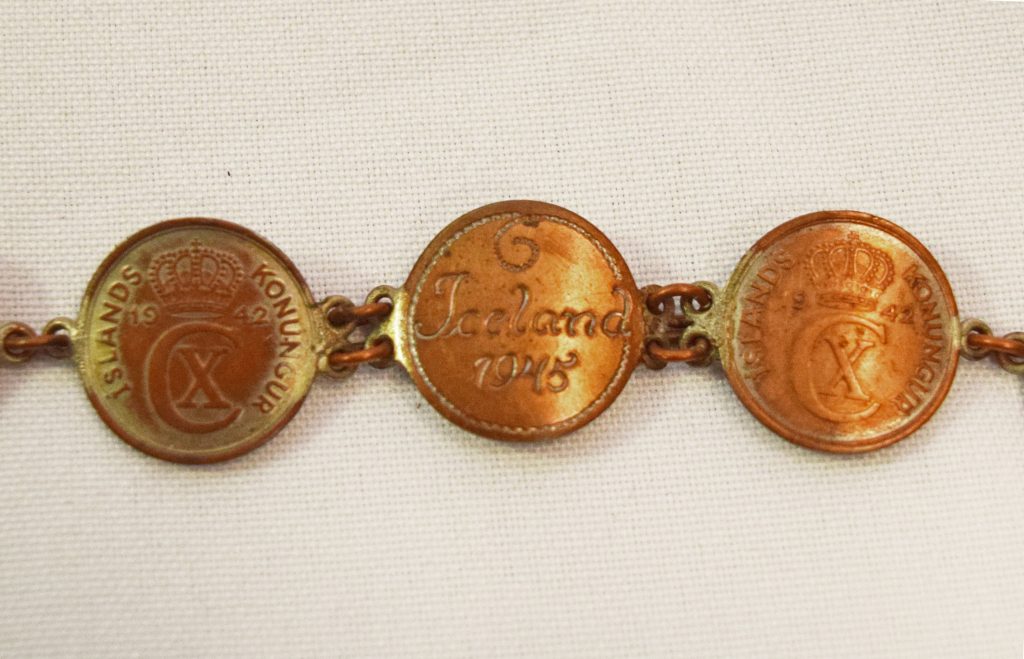This bracelet is made up of seven Icelandic coins from 1942, although the middle ones is stamped “Iceland 1945.” Four of them are two aurar coins (worth 0.02 krona, which were the currency in Iceland), and two of them are one eyrir (0.01 krona).
The museum actually has very little information on this bracelet because the donor found it washed up on a beach in White Rock in the 1960’s. That means that there is no original owner who could provide information about the piece and almost everything we know about it is from careful research and some theorizing. Luckily, the donor had conducted some research of his own, from which he theorized that this object was trench art, a theory that was reinforced through the museum’s research.
“Trench art” is a term that refers to pieces of art made by soldiers or civilians that relate directly to armed conflict or its consequences. The Maple Ridge Museum has other examples of trench art, including a vase made from a World War II shell casing and a small decoration made from a horse hoof hood and a grenade. This bracelet was likely acquired in the context of an armed conflict, specifically World War II, but it would more likely be called “sweetheart jewelry.” Sweetheart jewelry is a phrase used for jewelry brought back home by soldiers and sailors serving abroad as a souvenir for their sweethearts. Sometimes these pieces were handmade by soldiers, but there was also enough of a demand for them that many were machine crafted and sold to soldiers. This bracelet looks stylistically similar enough to other sweetheart jewelry from Iceland found in online listings that they were likely machine crafted and purchased by soldiers.
While this bracelet was likely brought back by a soldier or sailor, Iceland was never actually a sight of armed conflict in World War II. Iceland was neutral during the war, but Great Britain was concerned that Germany had too much of a diplomatic presence there. In 1940, Great Britain invaded to ensure that Iceland was not invaded or controlled by Germany. While there were Canadian battalions stationed there, they left in 1941 and the coins are all dated 1942, so it is unlikely that this bracelet was brought back by a Canadian. The bracelet actually likely belonged to an American soldier or sailor, as the “defence” of Iceland was transferred to the United States that year. Perhaps the original owner of the bracelet was an American soldier who arrived in 1942 (as there must have been a conscious effort to choose all coins from the same year, a random assortment of coins would likely be from several different years) and left in 1945, the year that the occupation officially ended. However, how the bracelet then made its way from Iceland to a beach in Canada is unknown. Overall, this piece is a very good example of the difficulties that a museum sometimes faces with presenting the history of an object. All that we really know is that this is a bracelet made of Icelandic coins from 1942, labelled “Iceland 1945,” that sometime made its way to Canada. Without miraculously finding the original owner of the artifact, we will never really know for sure the full story, and all that we can do is be thorough with our research and hope to find enough clues to put together its story.
This blog was research and written by Madelyn Huston, UBC

